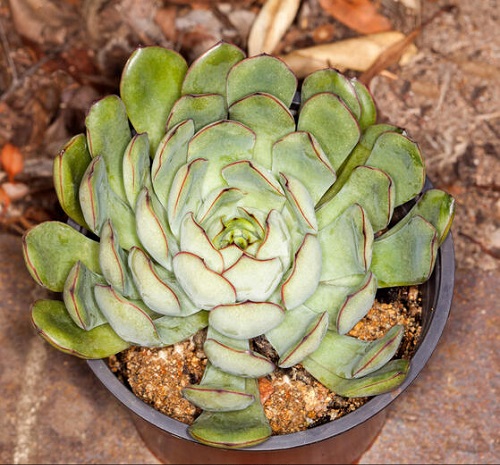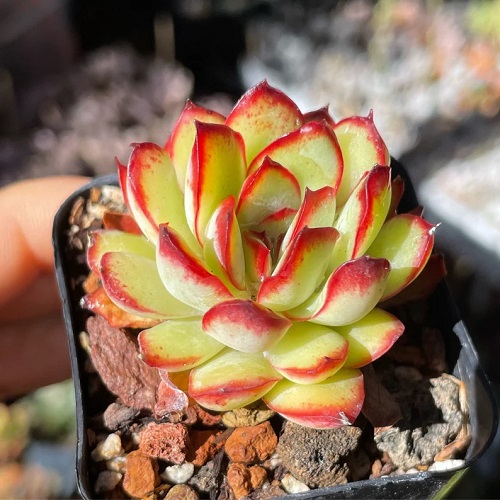Ready to take your indoor gardening to the next level? Start with our Echeveria pulidonis Indoor Care Guide!
Popular Mexican-born succulent —Echeveria pulidonis will sit gracefully in small planters, turning the bland corners of your home into a little green oasis. So, discover the joy of growing this beauty with our crisp and easy Echeveria pulidonis Indoor Care Guide!
- Botanical Name: Echeveria pulidonis
- Popular as Pulido’s Echeveria
- Grows up to 6-8 inches in height
- Prefers a temperature range of 60-75°F
- Thrives well in bright, direct sunlight
- Non-Toxic to humans & pets
Echeveria pulidonis Plant Profile
A low-demanding succulent, Echeveria pulidonis is prized for its distinctive, thick and fleshy, elongated leaves in green-gray color with striking berry-tinted tips. The slightly cupped leaves are arranged in a rosette that grows upto 15 cm in diameter and looks fantastic on center tables, bookshelves, and work desks.
Bright yellow flowers multiply the beauty of the pretty rosettes in the spring under favorable conditions. Echeveria pulidonis is a safe and lovely addition to any interior area because it is non-toxic to people and animals.
Ideal Pot Size
Being a succulent, Echeveria pulidonis prefers to be slightly root-bound, so get a pot that is one size bigger than the plant’s root ball. Ideally, a 4-6 inches container will be good enough while starting out. Ensure enough drainage holes at the bottom to aid aeration. You may need to move the plant to a size bigger container when you find it outgrowing its previous pot.
Terracotta pots are the best options considering their ability to maintain the moisture balance. However, do not restrict yourself from exploring other beautiful options, such as glossy ceramics, cute cups, plastic planters, and much more!
Propagating Echeveria pulidonis Indoors

Propagating Echeveria pulidonis via offsets is the easiest way to multiply this succulent! Offsets typically appear at the base of the main plant in the spring or summer.
- Gently separate the offset from the parent plant by carefully pulling it away with your fingers or using a clean, sharp knife or scissors to cut it away from the stem. Be sure to keep the roots intact.
- Allow the offset to callus over at a clean, dry spot. This will prevent any fungal infestation.
- Once the cut end has callused over, plant the offset in a well-draining potting mix or succulent soil.
- Mist the plant lightly to ensure the soil is moist but not waterlogged. Plant the offset deep enough so that the roots are covered but not so deep that the leaves are buried.
- Place the new plant in a location where it will receive plenty of light but avoid direct sunlight.
The offsets will root in a couple of weeks. Water the new plant sparingly, provide ample light, and keep it in a warm, dry location to help it thrive.
Requirements for Growing Echeveria pulidonis Indoors
Light
Echeveria pulidonis demands bright, direct sunlight to flourish indoors. Insufficient light can make it lanky, affecting the firm shape of the rosette. To ensure maximum sunlight for your plant, put it in a south-facing window, where it can receive at least 4-5 hours of bright sunlight daily.
If you don’t have a south-facing window, a west-facing window can also offer sufficient light. You can also supplement with a grow light if your home lacks natural sunlight. This hardy plant may grow and thrive indoors with the help of a full-spectrum grow lamp with a wavelength of about 6500K. It’s important to monitor your plant carefully and adjust its light exposure as needed.
Soil
A good potting mix for Echeveria pulidonis includes peat moss or coconut coir, coarse sand, and perlite to provide the perfect balance of organic matter and moisture retention, which helps to create air holes in the soil and reduce compaction. Ensure the mixture is not too heavy or accumulated since this can result in root rot. Alternatively, a ready-made cactus or orchid mix can be a good alternative.
Water
Echeveria pulidonis is drought-tolerant and does not require frequent watering, like most succulents. Water the plant sparingly and allow the soil to dry completely between waterings. Keep an eye on the top layer of the medium and water only when it feels absolutely dry to the touch.
Temperature & Humidity
The red-tipped succulent enjoys warm temperatures, although it may survive in a variety of conditions as long as the temperature doesn’t fall below zero or increase beyond 90 F or 32 C. The optimal temperature ranges between 60-75 F or 15-24 C. Do remember to keep the plant away from sudden temperature fluctuations or cold, or heat drafts as that will stunt the plant growth, fading the red tips.
Echeveria pulidonis prefers low humidity to thrive properly. Excessive humidity can lead to rot or fungal infections in the plant. It is essential to maintain the air moisture between 20 and 40% to provide the appropriate degree of humidity. You can use a dehumidifier or open windows to let air circulate if the indoor humidity level is higher than this.
Echeveria pulidonis Indoor Care
Fertilizer
This indoor succulent doesn’t require regular fertilization. However, it can benefit from a balanced NPK feed every 4-6 weeks during the spring and summer. Dilute the feed to 1/4th its strength to prevent chances of root burn.
Alternatively, you can use compost tea, worm castings, or fish emulsion if you prefer organic fertilizers. Organic fertilizers release the nutrients slowly and are less likely to burn the plant root.
Pest and Diseases
Echeveria pulidonis is a hardy plant, but like any indoor plant, it is susceptible to pests and diseases. Some common pests and diseases that can affect the plant include powdery mildew, mealybugs, spider mites, scales, and root rot. Wipe the leaves with a cotton dipped in rubbing alcohol or insecticidal neem oil solution.
Avoid overwatering the plant at all costs and provide good air circulation to keep potential issues at bay.









